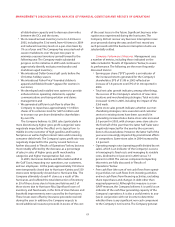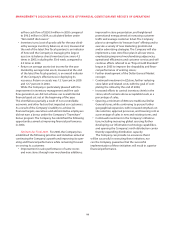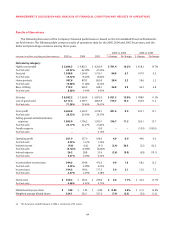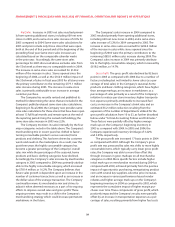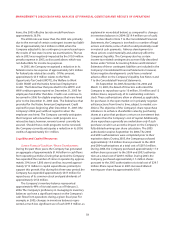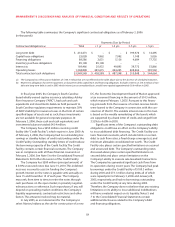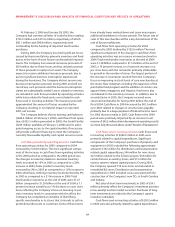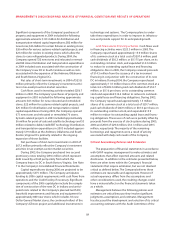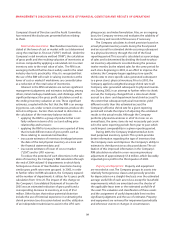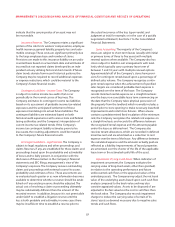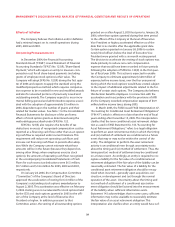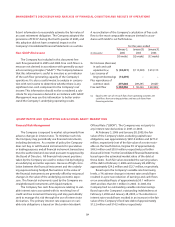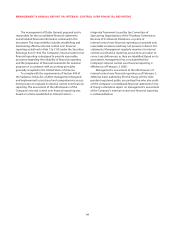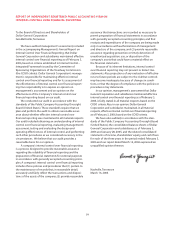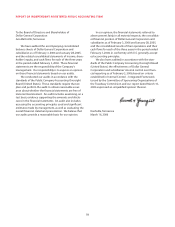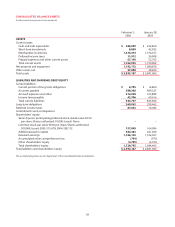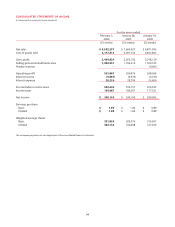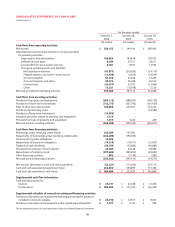Dollar General 2005 Annual Report Download - page 30
Download and view the complete annual report
Please find page 30 of the 2005 Dollar General annual report below. You can navigate through the pages in the report by either clicking on the pages listed below, or by using the keyword search tool below to find specific information within the annual report.
26
MANAGEMENT’S DISCUSSION AND ANALYSIS OF FINANCIAL CONDITION AND RESULTS OF OPERATIONS
Company’s Board of Directors and the Audit Committee
has reviewed the disclosures presented below relating
to them.
Merchandise Inventories. Merchandise inventories are
stated at the lower of cost or market with cost determined
using the retail last-in, first-out (“LIFO”) method. Under the
Company’s retail inventory method (“RIM”), the calculation
of gross profit and the resulting valuation of inventories at
cost are computed by applying a calculated cost-to-retail
inventory ratio to the retail value of sales. The RIM is an
averaging method that has been widely used in the retail
industry due to its practicality. Also, it is recognized that
the use of the RIM will result in valuing inventories at the
lower of cost or market if markdowns are currently taken
as a reduction of the retail value of inventories.
Inherent in the RIM calculation are certain significant
management judgments and estimates including,among
others,initial markups, markdowns, and shrinkage, which
significantly impact the gross profit calculation as well as
the ending inventory valuation at cost. These significant
estimates, coupled with the fact that the RIM is an averag-
ing process, can, under certain circumstances, produce dis-
torted cost figures. Factors that can lead to distortion in
the calculation of the inventory balance include:
• applying the RIM to a group of products that is not
fairly uniform in terms of its cost and selling price
relationship and turnover;
• applying the RIM to transactions over a period of time
that include different rates of gross profit, such as
those relating to seasonal merchandise;
• inaccurate estimates of inventory shrinkage between
the date of the last physical inventory at a store and
the financial statement date; and
• inaccurate estimates of lower of cost or market
(“LCM”) and/or LIFO reserves.
To reduce the potential of such distortions in the valu-
ation of inventory, the Company’s RIM calculation through
the end of 2004 utilized 10 departments in which fairly
homogenous classes of merchandise inventories having
similar gross profit rates were grouped. In 2005, in order
to further refine its RIM calculation, the Company expand-
ed the number of departments it utilizes for its gross profit
calculation from 10 to 23.The impact of this change on
the Company’s Consolidated Statement of Income for
2005 was an estimated reduction of gross profit and a
corresponding decrease to inventory, at cost, of $5.2
million. Other factors that reduce potential distortion
include the use of historical experience in estimating the
shrink provision (see discussion below) and the utilization
of an independent statistician to assist in the LIFO sam-
pling process and index formulation. Also, on an ongoing
basis, the Company reviews and evaluates the salability of
its inventory and records LCM reserves, if necessary.
The Company calculates its shrink provision based on
actual physical inventory results during the fiscal period
and an accrual for estimated shrink occurring subsequent
to a physical inventory through the end of the fiscal
reporting period. This accrual is calculated as a percentage
of sales and is determined by dividing the book-to-physi-
cal inventory adjustments recorded during the previous
twelve months by the related sales for the same period for
each store. Beginning in 2003, in an effort to improve this
estimate, the Company began applying store-specific
shrink rates to store-specific sales generated subsequent
to a given store’s physical inventory. Prior to 2003, the
Company applied a weighted-average shrink rate to all
Company sales generated subsequent to physical invento-
ries. During 2005, in an attempt to further refine its shrink
accrual, the Company changed from a store-level shrink
accrual to a store- and department-level shrink accrual.To
the extent that subsequent physical inventories yield
different results than this estimated accrual, the
Company’s effective shrink rate for a given reporting
period will include the impact of adjusting the estimated
results to the actual results. Although the Company
performs physical inventories in all of its stores on an
annual basis,the same stores do not necessarily get count-
ed in the same reporting periods from year to year, which
could impact comparability in a given reporting period.
During 2003, the Company implemented an item-
level perpetual inventory system. This system provides
better information regarding the type of inventory that
the Company owns and improves the Company’s ability to
estimate its shrink provision as discussed above.The uti-
lization of this improved information in the Company’s
RIM calculation resulted in a non-recurring inventory
adjustment of approximately $7.8 million, which favorably
impacted gross profit in the third quarter of 2003.
Property and Equipment. Property and equipment
are recorded at cost. The Company groups its assets into
relatively homogeneous classes and generally provides
for depreciation on a straight-line basis over the estimated
average useful life of each asset class, except for leasehold
improvements, which are amortized over the shorter of
the applicable lease term or the estimated useful life of
the asset.The valuation and classification of these assets
and the assignment of useful depreciable lives involves
significant judgments and the use of estimates. Property
and equipment are reviewed for impairment periodically
and whenever events or changes in circumstances



